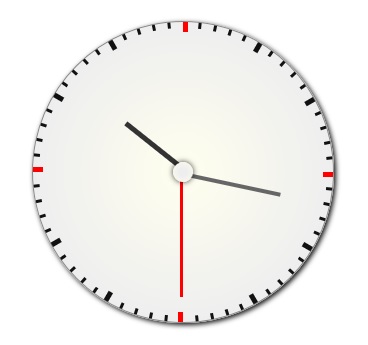Home >Web Front-end >JS Tutorial >jquery html5 makes a cool disc clock_jquery
jquery html5 makes a cool disc clock_jquery
- WBOYWBOYWBOYWBOYWBOYWBOYWBOYWBOYWBOYWBOYWBOYWBOYWBOriginal
- 2016-05-16 16:04:151438browse
A clock watch written in HTML5 jQuery that I packaged myself
Code:
<!DOCTYPE html PUBLIC "-//W3C//h2D XHTML 1.0 Transitional//EN" "http://www.w3.org/TR/xhtml1/h2D/xhtml1-transitional.h2d">
<html xmlns="http://www.w3.org/1999/xhtml">
<head>
<title>超酷数码钟表</title>
<script type="text/javascript" src="http://ajax.googleapis.com/ajax/libs
/jquery/1.10.2/jquery.min.js"></script>
<script type="text/javascript">
//引用的是在线jquery地址,如果不行请自行下载切换
(function($){
$.fn.drawClock = function(options){
var mainId = $(this);
//设置默认参数
var defaultOptions = {
'width': '300px',
'height': '300px',
'margin': '200px auto',
'border': '1px solid #888',
'border-radius': '50%',
'box-shadow': '2px 2px 4px #111'
};
var options = $.extend(defaultOptions, options);
mainId.css({
'width': options.width,
'height': options.height,
'margin': options.margin,
'border': options.border,
'border-radius': options['border-radius'],
'box-shadow': options['box-shadow'],
'position': 'relative'
}).css({
'background': '-webkit-gradient(radial, ' + mainId.width()/2 + ' ' + mainId.height()/2 + ', 0, ' + mainId.width()/2 + ' ' + mainId.height()/2 + ', ' + mainId.width()/2 + ', from(#ffe), to(#eee))',
'background': '-moz-radial-gradient(circle closest-side, #ffe 0%, #eee 100%)'
});
//钟表盘中心圆
$("<div id='circle'></div>").appendTo(mainId).css({
'width': '20px',
'height': '20px',
'border-radius': '50%',
'box-shadow': '0 0 5px rgba(0,0,0,0.8)',
'position': 'absolute',
'z-index': 999,
'background': '-webkit-gradient(radial, ' + mainId.width()/2 + ' ' + mainId.height()/2 + ', 0, ' + mainId.width()/2 + ' ' + mainId.height()/2 + ', ' + mainId.width()/2 + ', from(#ffe), to(#eee))',
'background': '-moz-radial-gradient(circle, #eee 30%, #ffe 100%)'
}).css({
'left': mainId.width()/2 - $('#circle').width()/2,
'top': mainId.height()/2 - $('#circle').height()/2
});
var dateTime = new Date();
var oHours = dateTime.getHours();
var oMinutes = dateTime.getMinutes();
var oSeconds = dateTime.getSeconds();
//初始化时分秒
var hPointer = drawPointer(mainId.width()/2, mainId.height()/2, mainId.width()/2*(3/6), 5, "#333", -90+oHours*30+oMinutes*6/12);
var mPointer = drawPointer(mainId.width()/2, mainId.height()/2, mainId.width()/2*(4/6), 4, "#666", -90+oMinutes*6);
var sPointer = drawPointer(mainId.width()/2, mainId.height()/2, mainId.width()/2*(5/6), 3, "#f00", -90+oSeconds*6);
//运动时分秒
var timer = setInterval(function(){
dateTime = new Date();
oHours = dateTime.getHours();
oMinutes = dateTime.getMinutes();
oSeconds = dateTime.getSeconds();
hPointer.css({'transform': 'rotate(' + (-90+oHours*30+oMinutes*6/12) + 'deg)'});
mPointer.css({'transform': 'rotate(' + (-90+oMinutes*6) + 'deg)'});
sPointer.css({'transform': 'rotate(' + (-90+oSeconds*6) + 'deg)'});
}, 1000);
//绘制钟表刻度
for(var i=0; i<60; i++){
var width = 3, height = 6, oBcolor = '#111';
if(i%5 == 0){
width = 5;
height = 10;
}
if(i%15 == 0){
oBcolor = 'red';
}
$("<div class='clockMark'></div>").appendTo(mainId).css({
'width': width,
'height': height,
'position': 'absolute',
'top': 0,
'left': mainId.width()/2,
'background': oBcolor,
'transform': 'rotate(' + i*6 + 'deg)',
"transform-origin": "0 " + mainId.width()/2+'px'
});
}
//绘制钟表指针
function drawPointer (startx, starty, width, height, bcolor, angle) {
var oPointer = $("<div></div>");
oPointer.appendTo(mainId).css({
'width': width,
'height': height,
'position': 'absolute',
'top': starty,
'left': startx,
'background': bcolor,
'transform': 'rotate(' + angle + 'deg)',
'transform-origin': '0 0'
});
return oPointer;
}
return this;
}
})(jQuery);
</script>
<script type="text/javascript">
$(function(){
$('#clock').drawClock();
});
</script>
</head>
<body>
<div id="clock"></div>
</body>
</html>
Demo picture:

The above is the entire content of this article, I hope you all like it.
Statement:
The content of this article is voluntarily contributed by netizens, and the copyright belongs to the original author. This site does not assume corresponding legal responsibility. If you find any content suspected of plagiarism or infringement, please contact admin@php.cn
Previous article:jQuery method to traverse all CheckBoxes on the page to see if they are selected_jqueryNext article:jQuery method to traverse all CheckBoxes on the page to see if they are selected_jquery
Related articles
See more- An in-depth analysis of the Bootstrap list group component
- Detailed explanation of JavaScript function currying
- Complete example of JS password generation and strength detection (with demo source code download)
- Angularjs integrates WeChat UI (weui)
- How to quickly switch between Traditional Chinese and Simplified Chinese with JavaScript and the trick for websites to support switching between Simplified and Traditional Chinese_javascript skills

